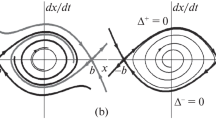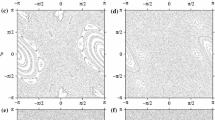Abstract
Through revisiting the four-dimensional chaotic system discussed in Wang et al. (Dyn Syst Control 8:129, 2019), its hidden dynamical behaviors that were not reported previously can be uncovered, such as the distribution and local stability of equilibrium points, generic and degenerate pitchfork bifurcation, Hopf bifurcation, the coexistence of true and pseudo-singularly degenerate heteroclinic cycles, and the existence of globally exponentially attractive sets as well as heteroclinic orbits. The innovation of the paper lies in the following results: (1) Coexisting pseudo-singularly degenerate heteroclinic cycles (the solution approaching infinity with a short-duration transient of singularly degenerate heteroclinic cycles) and true cycles consisting of normally hyperbolic saddle foci (or saddle nodes) and stable node foci are numerically illustrated with nearby hyperchaotic attractors, verifying a kind of mechanism for formulating hyperchaos. (2) Globally exponentially attractive sets with different exponential rates are located with the aid of the Lyapunov function. (3) The existence of a pair of symmetrically heteroclinic orbits is rigorously proven by the Lyapunov function; and the definitions of both the \(\alpha \)-limit set and \(\omega \)-limit set. Since these findings improve and complement the known results, we expect to provide a reference for real-world applications.









Similar content being viewed by others
Data Availability
There is no data because the results obtained in this paper can be reproduced based on the information given in this paper.
References
O E Rössler Phys. Lett. A 71 155 (1979)
G Grassi and S A Mascolo IEEE Trans Circuits Syst I 46 1135 (1999).
V S Udaltsov, J P Goedgebuer, L Larger, J B Cuenot P Levy and W T Rhodes, Opt. Spectrosc. 95 114 (2003)
Z Zhang, G Chen, and S Yu Int. J. Circuit Theor. Appl. 37 31 (2009)
B Cannas and S Cincotti Int. J. Circ. Theor. Appl. 30 625 (2002).
A Čenys, A Tamaševičius and A Baziliauskas R Krivickas and E Lindberg Chaos Soliton Fract. 17 349 (2003).
R Vicente, J Dauden, P Colet and R Toral IEEE J. Quantum Electron. 41 541 (2005)
S J Schiff, K Jerger, D H Duong, T Chang, M L Spano and W L Ditto Chaos Soliton Fract. 370 615 (1994)
A Neiman, X Pei, D Russell, W Wojtenek et al Phys. Rev. Lett. 82 660 (1999).
J Wang, G Chen and T Qin W Ni and X Wang Phys. Rev. E 58 3017 (1998)
Y Li and X Liu G Chen and X Liao Int. J. Circuit Theor. Appl. 39 865 (2011)
T Kapitaniak and L O Chua Int. J. Bifur. Chaos 4 477 (1994).
C Ning and H Haken Phys. Rev. A 41 3826 (1990).
L Yang, Q Yang and G Chen Commun. Nonlinear Sci. Numer. Simul. 28 18500581 (2018).
Q Deng, C Wang and L Yang Int. J. Bifur. Chaos 30 20500861 (2020)
H Wang and X Li Chaos Soliton Fract. 106 5 (2018).
H Wang and G Dong Appl. Math. Comput. 346 272 (2019).
H Wang and F Zhang Discr. Contin. Dyn. Syst. Ser. B 25 1791 (2020).
H Wang, H Fan and J Pan Int. J. Bifur. Chaos 31 21502081 (2021)
D Li, X Wu and J Lu Chaos Soliton Fract. 39 1290 (2009)
P Wang D Li and Q Hu Commun. Nonlinear Sci. Numer. Simul. 15 2514 (2010)
P Wang, D Li, X Wu, J Lü, and X Yu Int. J. Bifur. Chaos 21 2679 (2011)
F Zhang, Y Li and C Mu J. Math. Res. Appl. 33 345 (2013)
X Liao New Research on Some Mathematical Problems of Lorenz Chaotic Family (Wuhan: Huazhong University of Science & Technology Press) (2017)
G A Leonov, B R Mokaev, O A Andrievskiy and F Zhang Mathematics 50 15 (2017)
B Munmuangsaen and B Srisuchinwong Chaos Soliton Fract. 107 61 (2018).
J C Sprott and B Munmuangsaen Chaos Soliton Fract. 113 261 (2018).
Z Wang, H Niu and D Tan Dyn. Syst. Control 8 129 (2019)
J K Hale Ordinary Differential Equations (New York: Wiley) (1969)
J Guckenheimer and P Holmes Nonlinear Oscillations, Dynamical Systems, and Bifurcations of Vector Fields, 3rd edn. (Berlin: Springer) (1983)
S Wiggins Introduction to Applied Nonlinear Dynamical System and Chaos (New York: Springer) (2003)
Y A Kuzenetsov Elements of Applied Bifurcation Theory, Third ed. (New York: Springer) (2004)
T Li, G Chen and G Chen Int. J. Bifur. Chaos 16 3035 (2006)
G Tigan and D Constantinescu Chaos Soliton Fract. 42 20 (2009).
Y Liu and Q Yang Nonl. Anal.: RWA 11 2563 (2010).
X Li and H Wang Int. J. Bifur. Chaos 21 2695 (2011).
X Li and Q Ou Nonlinear Dyn. 65 255 (2011)
Y Liu and W Pang Nonlinear Dyn. 67 1595 (2012).
X Li and P Wang Nonlinear Dyn. 73 621 (2013).
Y Chen and Q Yang Nonlinear Dyn. 77 569 (2014).
H Wang and X Li Int. J. Bifur. Chaos 24 14501331 (2014).
H Wang and X Li Nonlinear Dyn. 80 969 (2015).
H Wang, C Li and X Li Int. J. Bifur. Chaos 26 16501941 (2016).
G Tigan and J Llibre Int. J. Bifur. Chaos 26 16500721 (2016).
H Wang and X Li Int. J. Bifur. Chaos 27 1750110 (2017).
X Li and H Wang J. Appl. Anal. Comput. 10 249 (2020).
H Wang, G Ke, J Pan, F Hu and H Fan Eur. Phys. J. Spec. Top. 359 (2022)
Acknowledgements
This work is supported in part by National Natural Science Foundation of China under Grant 12001489, in part by Natural Science Foundation of Zhejiang Guangsha Vocational and Technical University of construction under Grant 2022KYQD-KGY, in part by Zhejiang public welfare Technology Application Research Project of China under Grant LGN21F020003, in part by Natural Science Foundation of Taizhou University under Grant T20210906033, in part by NSF of Zhejiang Province under Grant LQ18A010001.
Author information
Authors and Affiliations
Corresponding author
Ethics declarations
Conflict of interest
The authors declare that they have no known competing financial interests or personal relationships that could have appeared to influence the work reported in this paper.
Additional information
Publisher's Note
Springer Nature remains neutral with regard to jurisdictional claims in published maps and institutional affiliations.
Rights and permissions
Springer Nature or its licensor (e.g. a society or other partner) holds exclusive rights to this article under a publishing agreement with the author(s) or other rightsholder(s); author self-archiving of the accepted manuscript version of this article is solely governed by the terms of such publishing agreement and applicable law.
About this article
Cite this article
Wang, H., Ke, G., Pan, J. et al. Revealing the true and pseudo-singularly degenerate heteroclinic cycles. Indian J Phys 97, 3601–3615 (2023). https://doi.org/10.1007/s12648-023-02689-w
Received:
Accepted:
Published:
Issue Date:
DOI: https://doi.org/10.1007/s12648-023-02689-w
Keywords
- Hyperchaotic system
- Bifurcation
- Singularly degenerate heteroclinic cycle
- Global exponentially attractive set
- Heteroclinic orbit
- Lyapunov function




